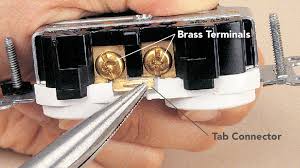So you tried to fix it and now it doesn’t work
Often we attempt to do repairs and replacements ourselves and it doesn’t work out as planned. Catastrophes are thankfully rare, but often the circuits won’t operate correctly, or at all, afterwards. In this piece we will try to anticipate your mistakes and help you to correct them, if we can.
Circuit breaker tripped, won’t turn back on:
Before you can turn on the circuit breaker you must reset it. Do this by moving the breaker to the extreme OFF position. If successful, you will hear a definitive click as the breaker resets. Then move the switch to the ON position. You should hear another click as you do this. Fully 10% of our service calls are to reset a circuit breaker.
Replaced outlets, now they trip the breaker when power is switched back on:
The most common of all household electrical installation errors is the Kitchen Counter Plug. For decades the electrical Code has required these be 3-wire circuits fed by 2-pole breakers. If this is your case you will see both a red and black wire on the hot lugs of your outlet. The new replacement outlet has a brass tab between the lugs that must be removed, or you will have a dead short between the red and black circuits. (see picture). To remove the tab, grab it with long nosed pliers and wiggle it laterally til it breaks off. If it doesn’t break off cleanly, nip off the extra material.

Removed old switch, marked wires, replaced switch, now we have a short or the lights aren’t working properly.
Marking the wires often doesn’t give you the info you need to reconnect correctly. Only an experienced hand with the proper tester can determine which wire does what. Switches have many aspects to consider (single pole, 3 way, 4 way, etc) and on top of this, other circuits are often spliced through the switch boxes on their way to other lights, plugs, appliances, etc. So there is a lot of opportunity for error in a switch box. Our sequence for correctly resplicing a switch box might proceed as follows:
- Identify the home run (the cable or cables) that go to the panel
- Identify the hot wires that continue along to feed outlets, other lights
- I.D. the load wires (the lights switched in the box in question) by sparking
- I.D. the switch leg wires (usually white) and separate from the neutrals
- Resplice accordingly
- If this is confusing, it is actually very simple compared to the job of making neat, tight splices
- The most dangerous result of amateur electrical work is fires caused by bad splices
- Splicing is a craft that can only be learned by repetition. Some people have a gift for it, others are cursed
A splice is merely the connection of wires, two or more. In household work in the present day this is done, at least on the lights, plugs, smaller appliances, by twisting the wires together and capping with an insulated connector like a wire nut or Marrette. To do this tightly and neatly requires a great deal of practice and teaching. If the wires are cut too long, or too short; if the insulation is stripped too much or too little, if there is too much jacket left in the box or too little, if too many wires are in the box, if some or all the wires are aluminum, sparking can result. Sparking is the cause of most electrical fires and heat damage, and it is the almost invariable result of improper splicing. As well, if the splices are not made up properly, the devices (switches, dimmers, outlets, etc) will not fit into the box and the results will look sloppy, even after the wall plates are installed. Amateur splices are obvious to the experienced eye; your electrician knows in a instant if your splices are done by a pro or not. If you have done any splicing in your home or business, or if you suspect amateur splices are to be found there, you should have Fairfield Electric check it out, and resplice as necessary.
Symptoms suggesting bad splicing are:
- Lights that dim, or blink,
- Switches that do not always work perfectly,
- Heat or odours from lights, plugs, switches or appliances.
